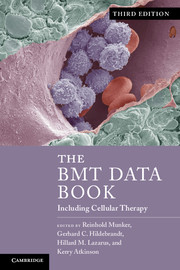Book contents
- Frontmatter
- Contents
- List of contributors
- Foreword
- Preface
- Acknowledgments
- Section 1 Basic science
- Section 2 Hematologic malignancies
- Section 3 Solid tumors
- Section 4 Nonmalignant disorders
- Section 5 Cellular therapy
- Section 6 Practical aspects and procedures
- Section 7 Complications
- 23 Pathobiology of graft-versus-host disease
- 24 Diagnosis and treatment of graft-versus-host disease
- 25 Management and prophylaxis of infections after BMT/SCT
- 26 Organ-related and miscellaneous complications
- Section 8 The BMT/SCT pharmacopoeia
- Section 9 HLA-testing and laboratory medicine
- Appendix Guide to the internet and literature databases relevant for BMT/SCT
- Index
- References
25 - Management and prophylaxis of infections after BMT/SCT
Published online by Cambridge University Press: 05 August 2013
- Frontmatter
- Contents
- List of contributors
- Foreword
- Preface
- Acknowledgments
- Section 1 Basic science
- Section 2 Hematologic malignancies
- Section 3 Solid tumors
- Section 4 Nonmalignant disorders
- Section 5 Cellular therapy
- Section 6 Practical aspects and procedures
- Section 7 Complications
- 23 Pathobiology of graft-versus-host disease
- 24 Diagnosis and treatment of graft-versus-host disease
- 25 Management and prophylaxis of infections after BMT/SCT
- 26 Organ-related and miscellaneous complications
- Section 8 The BMT/SCT pharmacopoeia
- Section 9 HLA-testing and laboratory medicine
- Appendix Guide to the internet and literature databases relevant for BMT/SCT
- Index
- References
Summary
Fever and neutropenia
HSCT preparative regimens are often marked by periods of neutropenia, during which the absolute neutrophil count (ANC) declines and remains at a low level for days or even weeks. Neutropenia as a consequence of cytoreductive chemotherapy is associated with the increased risk of serious infections (Bodey et al., 1966). This risk starts to increase when the ANC decreases to less than 1000 cells/mm3 and the infection risk increases further dramatically when ANC is less than 500 cells/mm3. Bloodstream infection develops in approximately 10%–25% of patients with an ANC less than 100 cells/mm3 (Freifeld et al., 2011; Ramphal, 2004; Wisplinghoff et al., 2003). Less often, pneumonia, cellulitis, CVC-related infections, or herpes virus reactivations will cause fever. The duration of ANC decline is also a critical determinant of infection risk, with longer durations being more likely to incur infection (Bodey et al., 1966). Full intensity HSCT recipients are typically neutropenic for at least 10–14 days or longer, and bacterial infections predominate as the infectious etiology of fever. Owing to routine prophylaxis, fungal and viral pathogens are much less common causes.
Reduced-intensity HSCT regimens are generally associated with shorter and less severe neutropenic periods, but these patients remain at high risk for infection in the immediate posttransplant period due to immunosuppression. This chapter focuses on the neutropenic HSCT recipient with fever.
- Type
- Chapter
- Information
- The BMT Data BookIncluding Cellular Therapy, pp. 330 - 347Publisher: Cambridge University PressPrint publication year: 2013



